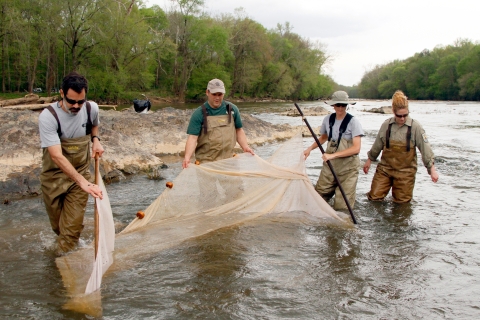What We Do
Endangered Species Conservation in North CarolinaEarly intervention to maintain biodiversityDocumenting populations of At-Risk Species is vital before declines and damage to populations escalate. Restoration and conservation activities can also be applied so protection under the Endangered Species Act becomes unnecessary. Managing protected speciesAccelerating recovery for species that are already protected or proposed for protection as threatened or endangered is a core component of our work. Plants and animals endemic to our state and neighboring states are a priority for us. We work cooperatively with the state of North Carolina and other partners to fulfill mandates, aspects of the ESA that only the Service can do including developing and publishing recovery plans, five-year reviews, down- and de-listing rules, responsibilities that cannot be delegated. Special emphasis is devoted to the Red Wolf Recovery Program with staff based in Manteo, North Carolina and a footprint on the five counties that comprise the Albemarle Peninsula: Beaufort, Dare, Hyde, Tyrrell and Washington counties. In Moore County, we deliver the Red-Cockaded Woodpecker Safe Harbor Agreement for the Sandhills Ecoregion. We also collaborate with biologists in other field offices to recover listed species having a broad geographic range (extending beyond our work area, but with significant populations locally). We provide expertise about the following species and their habitat requirements within eastern North Carolina: the Northern long-eared bat, dwarf wedgemussel, James spinymussel, shortnose sturgeon, red-cockaded woodpecker, Bermuda petrel, Great Lakes population of piping plover, Michaux’s sumac, Seabeach amaranth, Cooley’s meadowrue and rough-leaf loosestrife. Population managementSupporting other institutions holding and propagating rare species in captivity, and stocking captively raised individuals into appropriate habitat in the wild is fundamental for narrow endemic animals like the Carolina Madtom catfish, the Atlantic pigtoe mussel and the Magnificent ramshorn snail. Funding supportAssisting others identify funding sources to carry out habitat enhancement/restoration activities that benefit trust resources in their lands. Habitat conservationAssisting various federal agencies in analyzing impacts to fish and wildlife resources of the projects that they either perform, permit, license, or fund is a a core responsibility for many in our team. Guidance on how and when to submit a project for review can be in the Project Planning and Consultation section of our website. Habitat managementRestoring degraded streams and wetlands that are home to imperiled species. This can include identifying and eliminating sources of sediment, removing stream barriers such as decrepit dams, or controlling invasive exotic plants that threatened the nature of a habitat. When environmental contaminants are involved, we also assist identify harm and quantify damages caused to trust resources and assist in the recovery of damaged habitats that support trust resources. Coastal Program in North Carolina The National Coastal Program is one of the U.S. Fish and Wildlife Service’s most effective resources for restoring and protecting fish and wildlife habitat on public and privately-owned lands. North Carolina has a vast and rich coastal ecosystem that many people depend on for fishing, farming and recreational activities. In North Carolina, the coastal program works beyond our sandy beaches to help the extensive river system that empties into the Pamlico Sound and the Atlantic Ocean. Population shift and climate change climate change The North Carolina Coastal Program works with willing partners to restore and conserve coastal waters and wetlands. Recent work supported the federally protected plant, sensitive joint-vetch. At Mattamuskeet Refuge, Sensitive joint-vetch was last observed in 1995. The Raleigh Field Office (Coastal Program and Endangered Species biologist) and Mattamuskeet Refuge partnered with the NC Botanical Garden (NCBG) to reintroduce this rare plant to the Refuge. Barrier Islands and Estuary Focus AreaThis area supports many federally listed and at-risk species on the barrier islands and in the Albemarle Pamlico Estuary, the second largest estuary in the country. Cape Fear and Deep River Focus AreaThe Cape Fear and Deep Rivers provide important habitat to many listed and at-risk species and have the potential for great improvement with the continuation of on-going efforts. References
Atlantic White Cedar Restoration Project at Pocosin Lakes NWR Reports:
ContactMike Wicker, Coastal Program Coordinator, Raleigh Field Office at 919-856-4520, ext. 22 ormike_wicker@fws.gov |
Our Services
We offer multiple services connected to wildlife conservation:
|
Laws and Regulations
- Endangered Species Act
- Fish and Wildlife Coordination Act
- National Environmental Policy Act
- Clean Water Act
- Federal Power Act,
- Migratory Bird Treaty Act
- Bald and Golden Eagle Protection Act
- Partners for Fish and Wildlife Act








